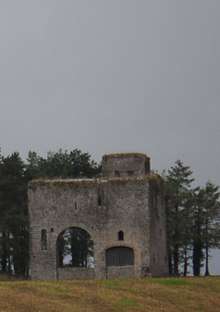Rathcoffey Castle
Rathcoffey Castle is a 15th century castle found in Rathcoffey, County Kildare, Ireland. It is a National Monument.
| Rathcoffey Castle | |
|---|---|
| Native name Irish: Caisleán Ráth Chofaigh | |
 Two-storey gatehouse, viewed from the rear (east) | |
| Type | Castle |
| Location | Rathcoffey Demesne, Rathcoffey, County Kildare, Ireland |
| Coordinates | 53.331676°N 6.665488°W |
| Built | 15th century |
| Architectural style(s) | Norman |
National Monument of Ireland | |
| Official name: Rathcoffey Castle | |
| Reference no. | 404 |
 Location of Rathcoffey Castle in Ireland | |
Location
Rathcoffey Castle is located in a field east of Rathcoffey village. It lies 4.3 km (2.7 mi) north-northwest of Straffan.
Building
The main surviving free-standing structure is the two-storey gatehouse leading to the enclosure in which the castle stood. It has a mullioned window in the east wall. It possibly dates to the 15th century.[1]
History
John Wogan was granted the Manor of Rathcoffey in 1317 and his descendants built a castle there. The Wogans were of Cambro-Norman extraction; the name is believed to derive from the Welsh Gwgan.[2] In 1417 Rathcoffey Castle was documented in a Wogan dower.
In 1453 an army led by Richard Wogan attacked and captured Rathcoffey Castle from his cousin Anne Eustace (née Wogan). Anne belonged to a more senior line, but Richard was the senior male heir. The result of this conflict left Richard in control of Rathcoffey and Anne and her successors in the Eustace family in possession of the Wogan lands of Clongowes Wood.
In 1580 William Wogan, joined the Second Desmond Rebellion in support of the Roman Catholic cause. He was executed the following year and all his lands forfeited. The family regained Rathcoffey soon afterwards.
During the Wars of the Three Kingdoms (1640s) the Wogans sided with Parliament, and Colonel Monck's army marched on Rathcoffey castle, laying siege to it. With the castle's fall in 1642 many civilians were massacred; their bones were found in a forest in the 19th century. The castle's garrison were executed in Dublin.[2]
In the 18th century the castle belonged to Richard Wogan Talbot. Archibald Hamilton Rowan (later a leading United Irishman) bought it from him in 1785 and built a new mansion on the site of the Castle incorporating the Wogan dwelling in this structure.
It later passed between numerous owners before coming into the possession of the Society of Jesus (Jesuits) and then being sold to a local farmer in the 1970s.[3]